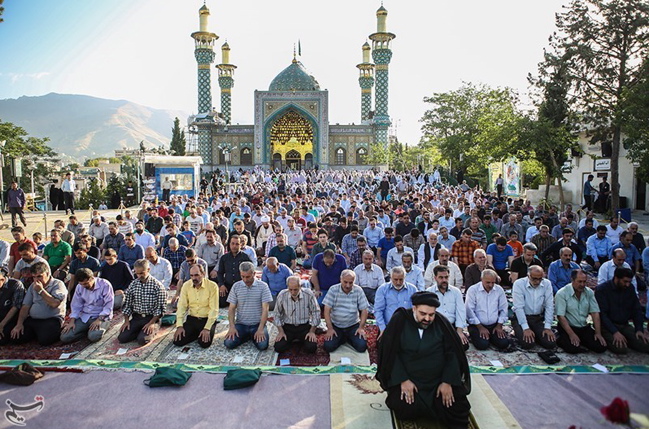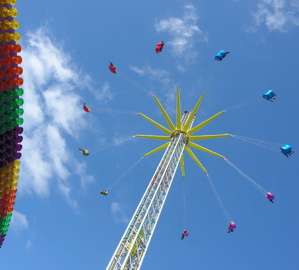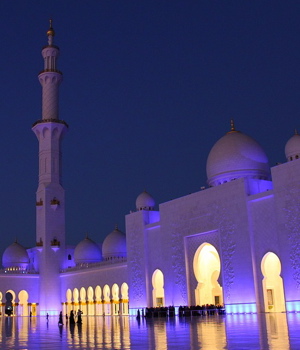
Muslims in Iran holding Eid al-Fitr prayer. Photo by M. Hasan Miremadi, courtesy of Wikimedia Commons
SUNSET SUNDAY, JUNE 10 and SUNSET THURSDAY, JUNE 14: The holiest night of the Islamic year arrives for Muslims worldwide with the Night of Power (Laylat al-Qadr). Known by many names—Night of Value, Night of Destiny, Night of Measure—Muslims note the anniversary of the night the Quran was first revealed to the Prophet Muhammad via the angel Gabriel. (Note: Muhammad did not reveal precisely when the Night of Power occurred, though the 27th day of Ramadan is a traditionally held date; however, as many of the odd-numbered nights in the last 10 days of Ramadan as possible are still observed.)
It is believed that on this sacred night, verses of the Quran were relayed to Muhammad in the year 610 CE, and angels descended to earth for the event. If a devoted Muslim prays in earnest for forgiveness of sins on Laylat al-Qadr and reads the Quran, it’s believed that the night is “better than 1,000 months.” Sins are forgiven and blessings are manifold.
I’TIKAF & THE FINAL DAYS OF RAMADAN
Muslims who can afford to spend the final 10 days of Ramadan in the mosque may choose to observe a form of worship known as I’tikaf. A fast observed during the day is supplemented with intense prayer and Quran study both day and night. Nighttime meals are provided by most mosques to I’tikaf participants. Ten days of observance is ideal, but some participants follow the practice for shorter periods. Both men and women are encouraged to observe I’tikaf.
Note: Due to traditional moon sighting calculations, Muslim observances often vary by country or region.
THE END OF RAMADAN: HAPPY EID!
Sunrise-to-sunset fasting through some of the year’s longest, hottest days has ended for the world’s Muslims, and the Islamic community transitions from the month of Ramadan to Shawwaal with a joyous “Feast of the Breaking of the Fast,” called Eid al-Fitr. Islamic days start at sunset, and for 2018, official astronomers have predicted that sunrise on June 14 will open Eid al-Fitr.
Note: Spellings vary, and you may see the holiday spelled Eid ul-Fitr as well. The proper greeting for this festival is “Eid Sa’id!” (Happy Eid!)
For the grand holiday, Muslims around the world awaken early, heading to a nearby mosque (or, in some cases, an open square or field) and praying in unison, before feasting with families and friends. Government buildings, schools and businesses close in Muslim countries as everyone visits family and friends, dines on sweet treats and greets passersby with a “Happy Eid.” In many regions, festivities will continue for three days or more.
Did you know? The first Eid was observed by the Prophet Muhammad in 624 CE.
Before sunrise on Eid al-Fitr, Muslims pray, bathe and put on their best clothing. A small breakfast—usually including dates—is consumed before heading to a nearby mosque, hall or open area. Zakat (charitable giving) has been completed, and adherents spend ample time enjoying the company of family and friends, attending carnivals and fireworks displays, giving gifts and expressing thanks to Allah.

Eid al-Fitr fairs and festivals, such as this one in Amsterdam, are common. Photo by Charles Roffey, courtesy of Flickr
The grand holiday of Eid al-Fitr is referred to in many ways: the Sugar Feast, Sweet Festival, Feast of the Breaking of the Fast and Bajram, to name just a few.
EID AROUND THE WORLD
With nearly one-quarter of the world’s population observing the Islamic faith, countries around the world are preparing their banks, airlines, shops, business hours and public services for the major holiday. Unlike most Muslim holidays, which may or may not be observed by all Muslims each year, the two Eid holidays—Eid al-Adha and Eid al-Fitr—are always commemorated universally.
Did you know? In Egypt, Eid al-Fitr is an occasion for neighborhood carnivals; in Asia, the celebratory dish contains toasted sweet vermicelli noodles and dried fruit; in Saudi Arabia, wealthy families buy large quantities of rice and other staples and leave them anonymously on the doorsteps of those less fortunate.
